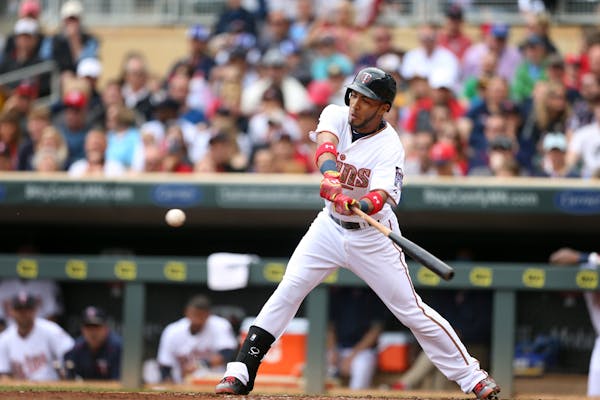The most difficult part about winning his 100th game, Ricky Nolasco said Monday, came not when he was standing on the mound but when he was sitting in the dugout. The Twins score so many runs these days, Nolasco said, who can stay loose?
This is not a problem the Twins have been familiar with for a while. But they are enjoying learning how to cope.
While Nolasco sat and waited, the Twins piled up seven runs for him in the first two innings, and the grateful righthander eventually coasted to a 7-2 victory over the Red Sox. It was the 100th win of Nolasco's career, his fifth this month, and the Twins' seventh in their past nine games. The Twins moved within two games of first-place Kansas City, the closest they have been to the top after April since winning the AL Central in 2010.
"Ricky was great. We congratulated him in the clubhouse," partly by making him dance in the team's daily post-victory boogie, manager Paul Molitor said. "I really didn't know how far he could go, but he just got locked in. His command got better as the game went on."
Something about Nolasco makes teammates' bats come alive, because the Twins have scored at least five runs in all five of his victories, most of them early. Nolasco has received 32 runs of support in his 28⅔ innings, compared to, say, the 23 Kyle Gibson has received in 56 innings of work. And since the Twins lead the majors in second-inning runs — their epic 12-batter, eight-hit, six-run second Monday gave them 37 for the season — Nolasco is learning how to deal with a lot of down time, midstart.
"I went in the [batting] cage, tried to throw some, stretch a little bit," said Nolasco, who is now 11-13 in two seasons with the Twins. "But pitching is timing and rhythm, and when you sit 45 minutes, I don't care who you are, it's going to be tough to find a little bit of rhythm."
Which explains the two runs he gave back in the third on three singles, until he got comfortable again. And when he did, Nolasco was more effective than he's been all year, lasting into the eighth inning (and the seventh, for that matter) for the first time in 2015. He retired 15 hitters in a row, needed only 103 pitches to set down 23 batters and received a loud ovation from the 29,472-strong Memorial Day crowd when he departed.
The crowd was getting used to cheering by then, because the Twins kept stacking up hits against Boston's ragged pitching staff — everyone in the lineup had at least one hit, and the bottom six in the order had at least two — and playing strong defense. Aaron Hicks made a diving catch to save a run, Eddie Rosario made a running grab at the wall to save two more, and Trevor Plouffe, whose three-run home run was the game's biggest hit, handled a couple of sharply hit balls to third.
"He's a confident player on both sides of the ball. I know our pitchers are pleased with the way he's playing" in the field, Molitor said. "Our outfield defense has improved. [Hicks] saved a run on a ball that I don't think a lot of people could have caught, [going] from the right field side of second base all the way to shallow left-center. Those are huge plays, and it just adds to the confidence of our pitchers."
And their success rate, too. Nolasco matched his career best with five victories in a month, took nearly a full run off his ERA (5.12) and joined Francisco Liriano, Johan Santana and Nick Blackburn as the only Twins of the past decade to win five consecutive starts. Reaching triple digits in victories is a nice achievement, too.
"It means a lot. … It's been a long road," said Nolasco, who the Twins hope is finally turning into the consistent winner they expected when they signed him to a four-year contract 17 months ago. "It's pretty special for me and my family. [I'll] just continue on and see how many I can rack up."
The Twins can't wait to find out, too.
Gordon, Jokic lead the Nuggets to the brink of a sweep with a 112-105 win over the Lakers in Game 3
Twins bring momentum into next series despite Angels Stadium struggles

Five home runs, including two by Julien, power Twins past White Sox


